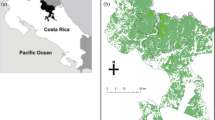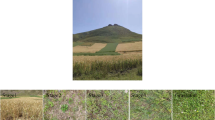Abstract
Little information exists on the responses of soil fungal and bacterial communities in high elevation coniferous forest/open meadow ecosystems of the northwest United States of America to treatments that impact vegetation and soil conditions. An experiment was conducted in which soil cores were reciprocally transplanted between immediately adjacent forests and meadows at two high elevation (∼1,600 m) sites (Carpenter and Lookout) in the H.J. Andrews Experimental Forest located in the Cascade Mountains of Oregon. Half of the cores were placed in PVC pipe (closed) to prevent new root colonization, whereas the other cores were placed in mesh bags (open) to allow recolonization by fine roots. A duplicate set of open and closed soil cores was not transferred between sites and was incubated in place. After 2 year, soil cores were removed and changes in fungal and bacterial biomasses determined using light microscopy, and changes in microbial community composition determined by PLFA analysis, and by length heterogeneity PCR of the internal transcribed spacer region of fungal ribosomal DNA. At both sites soil microbial community structures had responded to treatments after 2 year of incubation. At Carpenter, both fungal and bacterial community structures of forest soil changed significantly in response to transfer from forest to meadow, with the shift in fungal community structure being accompanied by a significant decrease in the PLFA biomarker of fungal biomass,18:2ω6,9. At Lookout, both fungal and bacterial community structures of forest soil changed significantly in response to open versus closed core treatments, with the shift in the fungal community being accompanied by a significant decrease in the 18:2ω6,9 content of closed cores, and the shift in the bacterial community structure being accompanied by a significant increase in bacterial biomass of closed cores. At both sites, fungal community structures of meadow soils changed differently between open and closed cores in response to transfer to forest, and were accompanied by increases in the18:2ω6,9 content of open cores. Although there were no significant treatment effects on the bacterial community structure of meadow soil at either site, bacterial biomass was significantly higher in closed versus open cores regardless of transfer.






Similar content being viewed by others
References
Anderson JPE, Domsch KH (1973) Quantification of bacterial and fungal contribution to soil respiration. Arch Microbiol 93:113–127
Anderson IC, Cairney JWG (2004) Diversity and ecology of soil fungal communities: increased understanding through the application of molecular techniques. Environ Microbiol 6:769–779
Axelrood PE, Chow ML, Radomski CC, McDermott JM, Davies J (2002) Molecular characterization of bacterial diversity from British Columbia forest soils subjected to disturbance. Can J Microbiol 48:655–674
Bååth E, Anderson T-H (2003) Comparison of soil fungal/bacterial ratios in a pH gradient using physiological and PLFA-based techniques. Soil Biol Biochem 35:955–963
Balser TC, Firestone MK (2005) Linking microbial community composition and soil processes in a California annual grassland and mixed-conifer forest. Biogeochemistry 73:395–415
Bottner P, Couteaux M-M, Anderson J M, Berg B, Billes G, Bolger T, Casabianca H, Romanya J, Rovira P (2000) Decomposition of 13C-labelled plant material in a European 65–40° latitudinal transect of coniferous forest soils: simulation of climate change by translocation of soils. Soil Biol Biochem 32:527–543
Bottomley PJ, Taylor AE, Boyle SA, McMahon SK, Rich JJ, Cromack Jr. K, Myrold DD (2004) Responses of nitrification and ammonia oxidizing bacteria to reciprocal transfers of soil between adjacent coniferous forest and meadow vegetation in the Cascade Mountains of Oregon. Microb Ecol 48:500–508
Boyle SA, Rich JJ, Bottomley PJ, Cromack Jr. K, Myrold DD (2006) Reciprocal transfer effects on denitrifying community composition and activity at forest and meadow sites in the Cascade Mountains of Oregon. Soil Biol Biochem 38:870–878
Brant J B, Myrold DD, Sulzman EW (2006) Root controls on soil microbial community structure in forest soils. Oecologia DOI:10.1007/s00442-006-0402-7
Brodie E, Edwards S, Clipson N (2003) Soil fungal community structure in a temperate upland grassland soil. FEMS Microbiol Ecol 45:105–114
Butler JL, Williams MA, Bottomley PJ, Myrold DD (2003) Microbial community dynamics associated with rhizosphere C flow. Appl Environ Microbiol 69: 6793–6800
Cullings K, Raleigh C, New MH, Henson J (2005) Effects of artificial defoliation of pines on the structure and physiology of the soil fungal community of a mixed pine-spruce forest. Appl Environ Microbiol 71:1996–2000
DeForest JL, Zak DR, Pregitzer KS, Burton AJ (2004) Atmospheric nitrate deposition and the microbial degradation of cellobiose and vanillin in a northern hardwood forest. Soil Biol Biochem 36:965–971
Fierer N, Craine JM, Mclauchlan K Schimel JP (2005a) Litter quality and the temperature sensitivity of decomposition. Ecology 86:320–326
Fierer N, Jackson JA, Vilgalys R, Jackson RB (2005b) Assessment of soil microbial community structure by use of taxon-specific quantitative PCR assays. Appl Environ Microbiol 71:4117–4120
Frey-Klett P, Chavatte M, Clausse M-L, Courrier S, Le Roux C, Raaijmakers J, Giovanna Martinotti M, Pierrat J-C, Garbaye J (2005) Ectomycorrhizal symbiosis affects functional diversity of rhizosphere fluorescent pseudomonads. New Phytol 165: 317–328
Gardes M, Bruns TD (1993) ITS primers with enhanced specificity for basidiomycetes-application to the identification of mycorrhizae and rusts. Mol Ecol 2:113–118
Gomes NCM, Fagbola O, Costa R, Rumjanek N G, Buchner A, Mendona-Hagler L, Smalla K (2003) Dynamics of fungal communities in bulk and maize rhizosphere soil in the tropics. Appl Environ Microbiol 69:3758–3766
Grayston SJ, Prescott CE (2005) Microbial communities in forest floors under four tree species in coastal British Columbia. Soil Biol Biochem 37:1157–1167
Hart SC, Perry DA (1999) Transferring soils from high to low-elevation forests increases nitrogen cycling rates: climate change implications. Global Change Biol 5:23–32
Hernesmaa A, Björklöf K, Kiikkilä O, Fritze H, Haahtela K, Romantschuk M (2005) Structure and function of microbial communities in the rhizosphere of Scots pine after tree-felling. Soil Biol Biochem 37:777–785
Ingham ER, Griffiths RP, Cromack Jr. K, Entry JA (1991) Comparison of direct vs. fumigation incubation microbial biomass estimates from ectomycorrhizal mat and non-mat soils. Soil Biol Biochem 23:465–471
Kennedy N, Brodie E, Connolly J, Clipson N (2004) Impact of lime, nitrogen and plant species on bacterial community structure in grassland microcosms. Environ Microbiol 6:1070–1080
Kennedy N, Connolly J, Clipson N (2005) Impact of lime, nitrogen and plant species on fungal community structure in grassland microcosms. Environ Microbiol 7:780–788
Leckie SE, Prescott CE, Grayston SJ, Neufeld JD, Mohn WW (2004) Characterization of humus microbial communities in adjacent forest types that differ in nitrogen availability. Microb Ecol 48:29–40
Lodge DJ, Ingham E (1991) A comparison of agar film techniques for estimating fungal biovolumes in litter and soil. Agric Ecosys Environ 34:131–144
McCune B, Grace JB (2002) Analysis of ecological communities. MjM Software, Gleneden Beach, Oregon
Mintie AT, Heichen RS, Cromack Jr. K, Myrold DD, Bottomley PJ (2003) Ammonia oxidizing bacteria along meadow-to-forest transects in the Oregon Cascade Mountains. Appl Environ Microbiol 69:3129–3136
Phillips RL, Zak DR, Holmes WE, White DC (2002) Microbial community composition and function beneath temperate trees exposed to elevated atmospheric carbon dioxide and ozone. Oecologia 131:236–244
Rich JJ, Heichen RS, Bottomley PJ, Cromack Jr. K, Myrold DD (2003) Community composition and functioning of denitrifying bacteria from adjacent meadow and forest soils. Appl Environ Microbiol 69:5974–5982
Schadt CW, Martin AP, Lipson DA, Schmidt SK (2003) Seasonal dynamics of previously unknown fungal lineages in tundra soils. Science 301:1359–1361
Schnürer J, Clarholm M, Rosswall T (1985) Microbial biomass and activity in an agricultural soil with different organic matter contents. Soil Biol Biochem 17:611–618
Siira-Pietikäinen A, Haimi J, Kanninen A, Pietikäinen J, Fritze H (2001) Responses of decomposer community to root isolation and slash. Soil Biol Biochem 33:1993–2004
Sowerby A, Emmett B, Beier C, Tietema A, Penuelas J, Estiarte M, Van Meeteren JM, Timonen S, Jørgensen KS, Haahtela K, Sen R (1998) Bacterial community structure at defined locations of Pinus sylvestris-Suillus bovinus and Pinus sylvestris-Paxillus involutus mycorrhizospheres in dry pine forest humus and nursery peat. Can J Microbiol 44:499–513
Waldrop MP, Firestone MK (2004a) Microbial community utilization of recalcitrant and simple carbon compounds: impact of oak-woodland plant communities. Oecologia 138:275–284
Waldrop M P, Firestone MK (2004b) Altered utilization patterns of young and old soil C by microorganisms caused by temperature shifts and N additions. Biogeochemistry 67:235–248
White DC, Ringelberg DB (1998) Signature lipid biomarker analysis. In: Burlage RS, Atlas D, Stahl D, Geesey G, Saylor G (eds) Techniques in microbial ecology. Oxford University Press, New York, pp 255–272
White TJ, Bruns T, Lee S, Taylor JW (1990) Amplification and direct sequencing of fungal ribosomal RNA genes for phylogenetics. In: Innis MA, Gelfand DH, Sninksky JJ, White TJ (eds) PCR protocols: a guide to methods and applications. Academic Press, New York, pp 315–322
Wu T, Sharda JN, Koide RT (2003) Exploring interactions between saprotrophic microbes and ectomycorrhizal fungi using protein-tannin complex as an N source by red pine (Pinus resinosa). New Phytol 159:131–139
Wu T, Kabir Z, Koide RT (2005) A possible role for saprotrophic microfungi in the N nutrition of ectomycorrhizal Pinus resinosa. Soil Biol Biochem 37:965–975
Acknowledgements
Support for this work was provided by grants from the National Science Foundation Microbial Observatory Program (MCB-9977933 and MCB-0348689) and by the Oregon Agricultural Experiment Station. We acknowledge the NSF Long Term Ecological Research program for infrastructure support at the H.J. Andrews Experimental Forest. We acknowledge various present and past members of our laboratory for assistance in site set up, soil sampling, and preparation. The staff of the Central Analytical Services Laboratory of the Center for Gene Research and Biotechnology is thanked for their help and guidance with Gene Scan analyses.
Author information
Authors and Affiliations
Corresponding author
Rights and permissions
About this article
Cite this article
Bottomley, P.J., Yarwood, R.R., Kageyama, S.A. et al. Responses of soil bacterial and fungal communities to reciprocal transfers of soil between adjacent coniferous forest and meadow vegetation in the Cascade Mountains of Oregon. Plant Soil 289, 35–45 (2006). https://doi.org/10.1007/s11104-006-9095-2
Received:
Accepted:
Published:
Issue Date:
DOI: https://doi.org/10.1007/s11104-006-9095-2




